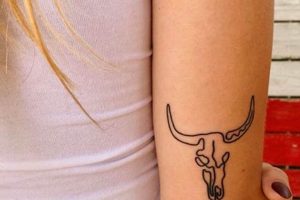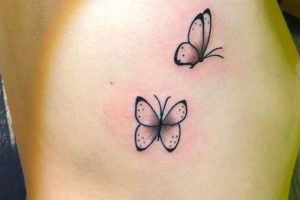Temporary skin decoration using henna paste offers a painless and versatile alternative to permanent tattoos. Designs range from basic geometric shapes and floral motifs to delicate patterns and minimalist symbols, allowing for artistic expression without long-term commitment. Examples include small flowers, leaves, hearts, or simple lines and dots strategically placed on the hands, feet, or ankles.
The practice of henna art holds cultural significance in various traditions, particularly in South Asia, the Middle East, and Africa, often associated with celebrations and rites of passage. Its temporary nature makes it appealing for those who wish to explore body art without permanence. The natural dye derived from the henna plant typically stains the skin a reddish-brown color, creating visually appealing temporary adornments.
Further exploration will delve into specific design categories, application techniques, and aftercare practices for achieving optimal results with these ephemeral artworks.
Tips for Temporary Skin Decoration with Henna
Achieving aesthetically pleasing and long-lasting results with henna requires careful consideration of design choices and application techniques. The following tips offer guidance for successful temporary skin decoration.
Tip 1: Start with Simple Designs: Intricate patterns can be challenging for beginners. Opting for basic shapes, lines, or small floral motifs allows for skill development and prevents overwhelming complexity.
Tip 2: Prepare the Skin: Cleanse the application area thoroughly with soap and water. Exfoliating the skin beforehand can enhance stain vibrancy and longevity.
Tip 3: Use Quality Henna Paste: Fresh, finely sifted henna powder yields the best results. Avoid pre-mixed cones containing additives or chemicals, as these can compromise stain quality and skin health.
Tip 4: Practice Application: Experimenting on paper or practice skin allows one to become comfortable with the applicator cone and develop control over line thickness and consistency.
Tip 5: Allow Adequate Drying Time: Henna paste requires several hours to dry completely. Keeping the area covered with a breathable material can help prevent smudging and enhance stain development.
Tip 6: Seal the Design: After the paste has dried, applying a sealant, such as a mixture of sugar and lemon juice, can help maintain moisture and prolong contact with the skin.
Tip 7: Avoid Water: Minimize contact with water for at least six hours after paste removal to allow the stain to fully develop. Longer avoidance periods can result in darker, more lasting stains.
Following these guidelines can contribute to a satisfying henna experience, resulting in beautiful, temporary body art.
These insights into design selection, preparation, and application contribute to a successful henna experience. A subsequent section will address potential challenges and offer solutions for troubleshooting common issues.
1. Small Floral Motifs
Small floral motifs represent a cornerstone of simple henna tattoo ideas. Their versatility, ease of application, and aesthetic appeal make them a popular choice for both beginners and experienced henna artists. Exploring the facets of these motifs provides insight into their significance within the broader context of temporary skin decoration.
- Simplicity and Elegance
The inherent simplicity of small floral designs allows for effortless integration into various henna patterns. Single blossoms, buds, or small clusters of flowers can be strategically placed to create elegant and understated designs, ideal for those seeking minimalist aesthetics. A single lotus blossom on the back of the hand, for example, offers a touch of elegance without overwhelming the overall composition.
- Versatility and Adaptability
Floral motifs adapt readily to different body placements and can be incorporated into larger, more complex designs. A trail of small flowers can gracefully wind around a finger, while a cluster of blossoms can adorn the wrist or ankle. This adaptability makes them suitable for a wide range of aesthetic preferences and occasions.
- Cultural Significance and Symbolism
Specific flowers hold symbolic meaning in various cultures. Roses, lotuses, and jasmine, for example, represent love, purity, and beauty, respectively. Incorporating these symbolic elements can imbue a henna design with deeper cultural significance and personal meaning.
- Ease of Application for Beginners
The relatively simple shapes and lines involved in creating small floral motifs make them an excellent starting point for beginners. Mastering these basic elements provides a foundation for developing more complex henna artistry skills. Practicing with simple petals and leaves allows novices to gain confidence and control over the application process.
The combination of simplicity, versatility, cultural significance, and ease of application establishes small floral motifs as a fundamental component within simple henna tattoo ideas. These motifs offer a pathway to exploring the art of temporary skin decoration, allowing individuals to express creativity and personal style through ephemeral botanical adornments.
2. Geometric Patterns
Geometric patterns play a significant role in simple henna tattoo ideas, offering structured beauty and symbolic depth. Their inherent precision and adaptability make them a versatile choice for both novice and experienced henna artists. Straight lines, triangles, squares, circles, and other geometric shapes combine to create visually appealing designs ranging from minimalist bands to intricate mandalas. The repetitive nature of these patterns contributes to a sense of balance and harmony, echoing the symmetrical qualities often found in traditional henna art.
Practical application of geometric patterns in simple henna designs offers several advantages. Clean lines and defined shapes are relatively easy to execute, even for beginners. Moreover, these patterns can be scaled and combined in countless variations, enabling personalized designs that reflect individual preferences. A series of concentric circles, for example, can symbolize unity and wholeness, while intersecting lines may represent interconnectedness. Incorporating these symbolic elements elevates the aesthetic value and cultural significance of the henna art.
Understanding the interplay between geometric patterns and simple henna tattoo ideas allows for deeper appreciation of this ancient art form. The precision of geometric design complements the fluidity of the henna paste, creating ephemeral masterpieces that adorn the skin with both visual appeal and symbolic meaning. Exploration of various cultures reveals the rich history and diverse applications of geometric patterns in traditional henna designs, offering inspiration for contemporary interpretations of this enduring art form. This understanding facilitates informed design choices and empowers individuals to create meaningful temporary body art.
3. Minimalist Symbols
Minimalist symbols represent a powerful component within simple henna tattoo ideas. Their concise visual language allows for potent expressions of personal meaning and aesthetic appreciation within the constraints of temporary skin decoration. The inherent simplicity of these symbols facilitates both design and application, making them ideal for beginners and those seeking understated elegance. A single dot, for example, can symbolize a seed of potential, while a minimalist wave can evoke a sense of tranquility and flow. The deliberate reduction of form to its essential elements emphasizes the symbolic power of these designs, allowing for profound statements with minimal visual complexity.
The effectiveness of minimalist symbols in henna art stems from the inherent contrast between the intricate detail often associated with traditional henna and the stark simplicity of these reduced forms. This contrast creates visual interest and draws attention to the symbolic meaning embedded within the design. A small, unadorned triangle, for example, can represent strength and stability, while a simple crescent moon can evoke femininity and cycles of change. The judicious placement of these symbols further amplifies their impact, transforming a small area of skin into a canvas for personal expression. Choosing a minimalist symbol often reflects a desire for understated elegance and a focus on symbolic resonance over elaborate ornamentation.
Understanding the role of minimalist symbols in simple henna tattoo ideas allows for a nuanced appreciation of this art form’s adaptable nature. The ability to convey complex ideas through simplified visual representations empowers individuals to create deeply personal and aesthetically pleasing temporary body art. This minimalist approach fosters creative expression while respecting the ephemeral nature of henna, allowing for a harmonious blend of simplicity and symbolic depth. The intentional selection and placement of minimalist symbols contribute to the overall narrative conveyed by the henna design, transforming a temporary adornment into a powerful expression of personal identity and aesthetic values.
4. Delicate Linework
Delicate linework forms an integral aspect of simple henna tattoo ideas. Fine lines, subtly applied, contribute significantly to the overall aesthetic of the design. The thinness of these lines allows for intricate detail without overwhelming visual complexity, a crucial characteristic of simple henna art. This technique enables the creation of delicate floral patterns, intricate geometric designs, and minimalist representations, all while maintaining an understated elegance. The precision required for delicate linework necessitates a skilled hand and control over the henna application cone. The resulting designs often exhibit a graceful flow and ethereal quality, enhancing the ephemeral nature of the art form. A vine of thin, gently curving lines, for example, can evoke a sense of natural growth and delicate beauty, while finely drawn geometric patterns can create an impression of intricate lacework on the skin.
Practical applications of delicate linework within simple henna designs are numerous. Fine lines can be used to create subtle shading and depth, enhancing the visual dimension of otherwise flat designs. They also allow for the incorporation of intricate details, such as the delicate veins of a leaf or the fine texture of a feather, without compromising the overall simplicity of the design. This attention to detail elevates the aesthetic value of the henna art, transforming a simple motif into a miniature work of art. The ability to manipulate line thickness and density contributes to the versatility of this technique, enabling artists to create a wide range of visual effects. The subtle variations in line weight create a sense of movement and dynamism, adding to the overall impact of the design.
Understanding the significance of delicate linework within simple henna tattoo ideas is essential for both the artist and the admirer. The mastery of this technique allows for the creation of intricate and aesthetically pleasing designs that embody the essence of simple henna art. The delicate lines, meticulously applied, enhance the ephemeral beauty of the henna stain, creating temporary masterpieces that celebrate the interplay of skill, artistry, and the natural world. The appreciation of delicate linework deepens the understanding of the artistry involved in creating simple, yet impactful henna designs, highlighting the power of subtle detail in ephemeral art forms.
5. Placement Considerations
Placement considerations are essential for maximizing the impact of simple henna tattoo ideas. Strategic placement enhances the aesthetic appeal and symbolic meaning of the design, transforming temporary skin decoration into a thoughtful expression of personal style. The placement of a henna design interacts with the body’s natural contours and movements, creating a dynamic interplay between art and anatomy. A simple band of henna encircling the wrist, for example, emphasizes the elegance of the wrist’s slender form, while a delicate floral motif cascading down the hand draws attention to the hand’s graceful movements. Choosing a placement that complements both the design and the individual’s body shape ensures a harmonious and visually appealing result. Cultural traditions and personal preferences also play a crucial role in placement decisions, further enhancing the significance of the henna art.
Practical applications of placement considerations extend beyond mere aesthetics. The visibility of a henna tattoo, its susceptibility to wear and tear, and its interaction with clothing and jewelry are all factors influenced by placement. A henna design on the hand, for example, is more likely to be noticed than a design on the back, while a design on the foot may experience greater wear due to friction from footwear. Considering these practicalities ensures the longevity and visual impact of the henna art. Additionally, specific placements may hold symbolic meaning in certain cultures. Henna applied to the palms of the hands, for instance, is often associated with blessings and good fortune in some traditions. Understanding these cultural nuances adds depth and significance to the placement decision.
Careful consideration of placement elevates simple henna tattoo ideas from mere decoration to meaningful expressions of personal style and cultural identity. Understanding the interplay between placement, design, and individual anatomy allows for informed choices that enhance both the aesthetic and symbolic value of the henna art. Strategic placement maximizes the visual impact of even the simplest designs, transforming temporary body art into a powerful form of self-expression. This understanding allows individuals to appreciate the multifaceted nature of henna as an art form and to make informed decisions that align with their personal aesthetics and cultural values.
6. Cultural Significance
Cultural significance forms an intrinsic layer within simple henna tattoo ideas, enriching temporary adornment with historical context and symbolic depth. Henna’s use transcends mere decoration; it often plays an integral role in cultural practices, rituals, and celebrations across various societies. In many South Asian, Middle Eastern, and African cultures, henna application accompanies rites of passage, weddings, and religious festivals. Specific motifs, patterns, and placements hold symbolic meaning, conveying blessings, protection, or auspiciousness. A simple paisley motif, for instance, might represent fertility in one culture, while a series of dots could symbolize prosperity in another. Understanding the cultural context informs design choices and imbues simple henna tattoos with deeper meaning.
The connection between cultural significance and simple henna tattoo ideas offers practical considerations for both artists and individuals seeking temporary body art. Respecting cultural traditions necessitates awareness of symbolic meanings and appropriate application contexts. A simple spiral, for example, may hold spiritual significance in some cultures, while a specific floral motif might be reserved for particular ceremonies. Acknowledging these cultural nuances avoids unintentional misrepresentation or appropriation. Furthermore, understanding cultural origins allows for informed design choices, fostering appreciation for the rich history and diverse traditions associated with henna art. Choosing a design based on its cultural meaning adds a layer of depth and authenticity to the temporary adornment.
Recognizing the cultural significance embedded within simple henna tattoo ideas transforms temporary body art into a powerful medium for cultural expression and appreciation. Acknowledging the historical and symbolic context enriches both the creation and interpretation of henna designs. This understanding fosters respect for diverse cultural traditions, promoting meaningful engagement with the art form beyond mere aesthetics. Simple henna tattoos, imbued with cultural significance, become more than just temporary decorations; they serve as tangible links to rich histories and vibrant traditions, celebrating the enduring power of art to connect individuals to their cultural heritage.
7. Hand and Foot Designs
Hand and foot designs constitute a prominent category within simple henna tattoo ideas. Their prevalence stems from several factors, including the accessibility and visibility of these body areas, as well as established cultural traditions. Intricate patterns adorning hands and feet feature prominently in various cultural celebrations and rituals, particularly in South Asian, Middle Eastern, and African communities. The flat surfaces and relatively stable skin of the palms and soles provide ideal canvases for intricate henna application. Simple henna designs on hands and feet can range from minimalist geometric patterns to delicate floral motifs, offering adaptable options for various skill levels and aesthetic preferences. A simple series of dots and lines along the fingers, for example, can create a subtle yet elegant effect, while a single, stylized flower on the back of the hand offers a touch of understated beauty. The cultural significance associated with hand and foot henna further enhances their appeal, transforming temporary adornment into a meaningful expression of cultural identity.
Practical considerations influence the popularity of hand and foot designs within simple henna tattoo ideas. The visibility of these placements allows for easy display and appreciation of the artistry. Furthermore, the relatively limited surface area of hands and feet lends itself well to simpler designs, making them ideal for beginners or those seeking less elaborate adornment. The symmetrical nature of hands and feet also allows for balanced and visually harmonious designs. A mirrored pattern on both hands, for instance, creates a sense of visual symmetry and aesthetic balance. The practicalities of application also contribute to the prevalence of hand and foot designs. The relative stability of these body parts during the application process minimizes smudging and facilitates intricate detail work, even for those with less experience in henna artistry.
The enduring popularity of hand and foot designs within simple henna tattoo ideas underscores the interplay of cultural significance, aesthetic appeal, and practical considerations. These designs offer a versatile canvas for artistic expression, allowing for both minimalist elegance and intricate detail. Understanding the historical and cultural context of hand and foot henna enhances appreciation for this art form’s enduring appeal, transforming temporary adornment into a powerful expression of personal style and cultural identity. This understanding provides a foundation for informed design choices, enabling individuals to select patterns and placements that resonate with their personal aesthetics and cultural values.
Frequently Asked Questions
Addressing common inquiries regarding temporary skin decoration with henna clarifies practical aspects and promotes informed decision-making.
Question 1: How long do henna tattoos last?
Longevity varies depending on factors like skin type, placement, and aftercare. Typically, henna stains last one to three weeks before gradually fading.
Question 2: Is henna safe for all skin types?
Generally, natural henna is safe. However, individuals with sensitive skin should perform a patch test before application. Avoid “black henna” as it often contains a chemical dye that can cause allergic reactions.
Question 3: How can stain darkness be maximized?
Allowing the paste to remain on the skin for an extended period, applying a sugar-lemon sealant, and avoiding water contact after paste removal can contribute to darker stains.
Question 4: How is henna paste removed?
Once dry, the paste can be gently scraped off with a blunt tool or allowed to flake off naturally. Avoid washing the area immediately after paste removal.
Question 5: Can henna be applied to any body part?
While henna can be applied to most body areas, avoiding sensitive areas like the face, particularly around the eyes, is recommended.
Question 6: Where can quality henna supplies be purchased?
Reputable online retailers, ethnic stores, and specialty shops often carry high-quality henna powder and application cones. Seek vendors specializing in natural henna products.
Addressing these common questions provides a foundation for informed decisions regarding temporary skin decoration with henna, ensuring safe and successful results.
Exploring additional resources can further enhance understanding and appreciation for this art form.
Simple Henna Tattoo Ideas
Exploration of simple henna tattoo ideas reveals a versatile art form adaptable to various skill levels and aesthetic preferences. From delicate linework and minimalist symbols to small floral motifs and geometric patterns, the possibilities for temporary skin decoration are extensive. Strategic placement and consideration of cultural significance further enhance the impact of these ephemeral designs. Understanding proper application techniques, aftercare practices, and the selection of quality materials contributes to achieving optimal results and maximizing the longevity of henna stains.
The enduring appeal of simple henna tattoo ideas lies in the harmonious balance between artistic expression, cultural significance, and temporary adornment. This accessible art form offers a unique opportunity to explore personal style, celebrate cultural heritage, and embrace the beauty of impermanence. Continued exploration and experimentation within this artistic realm promise further evolution and innovation, ensuring the enduring legacy of henna as a powerful medium for self-expression and cultural storytelling.







